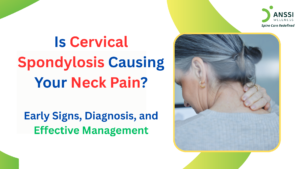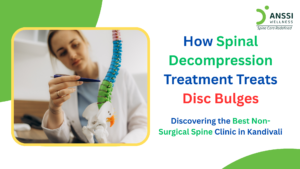Dizziness, lightheadedness, or a sensation of spinning can be unsettling, especially when the source is not the inner ear or brain, but the neck. This condition is known as cervical vertigo, and it’s more common than many people realise.
Whether caused by neck injuries, poor posture, or degenerative spinal issues, cervical vertigo is often misunderstood and misdiagnosed. Understanding the causes is essential for proper treatment and long-term relief.
What is Cervical Vertigo?
Cervical vertigo (or cervicogenic dizziness) refers to a type of dizziness that stems from abnormalities or dysfunctions in the cervical spine, the upper portion of the spinal column located in the neck.
The cervical spine plays a critical role in maintaining balance and spatial awareness, thanks to its close association with nerve signals, muscles, and blood vessels. When something goes wrong in this region, it can disrupt these signals and lead to dizziness, disorientation, and unsteadiness.
Typical symptoms include:
- Dizziness or a spinning sensation
- Neck pain or stiffness
- Headaches
- Poor balance or unsteady gait
- Nausea (in some cases)
The symptoms often worsen with head or neck movement and can interfere with daily activities.
Causes of Cervical Vertigo
Cervical vertigo may be caused by structural or movement-related problems in the neck that impact balance and coordination. Beyond that, certain neurological factors involving nerve and blood vessel compression can also trigger cervical vertigo.
1. Whiplash Injuries
Whiplash is a common cause of cervical vertigo, particularly after car accidents or sudden jerks to the neck. The rapid back-and-forth movement can damage ligaments, muscles, and joints in the neck, leading to inflammation and instability. These injuries can impair the neck’s proprioception, the sense of position and movement, which affects balance and triggers dizziness.
2. Poor Posture
Modern lifestyle habits, especially long hours at a desk or looking down at mobile screens, have made poor posture a major contributor to cervical vertigo. A forward head posture increases strain on the cervical spine, compressing joints and altering muscle function. Over time, this can disrupt the feedback loop between the neck and the brain responsible for maintaining balance.
3. Muscle Tension and Spasms
Chronic muscle tightness in the neck, especially in the levator scapulae, trapezius, or sternocleidomastoid muscles, can compress nearby nerves or alter sensory input. This leads to confusion in the balance centres of the brain and contributes to dizziness and unsteadiness.
4. Cervical Spondylosis
Age-related wear and tear in the cervical spine, known as cervical spondylosis, is another frequent mechanical cause. The degeneration of intervertebral discs and facet joints can reduce flexibility and compress spinal nerves. When this affects proprioceptive feedback or blood flow to the brainstem, vertigo symptoms may appear.
5. Herniated Cervical Discs
A herniated disc occurs when the soft inner material of a spinal disc pushes through its outer layer, potentially compressing a nearby nerve root or vertebral artery. In the cervical spine, this compression can disturb the vestibular system, the network responsible for balance, and lead to vertigo.
The compression may also cause radiating pain, numbness, or tingling in the arms and hands. If the spinal cord is involved, the symptoms may include coordination problems or difficulty walking.
6. Degenerative Disc Disease
Over time, the spinal discs naturally lose hydration and flexibility. This degeneration can lead to reduced disc height and abnormal movement between vertebrae. When these changes affect the cervical spine, they may irritate spinal nerves or compromise blood flow through the vertebral arteries, which supply the brainstem. This can result in symptoms such as dizziness, visual disturbances, and even ringing in the ears (tinnitus).
How Are Cervical Vertigo Causes Diagnosed?
Proper diagnosis is crucial. Because dizziness can originate from many systems, such as inner ear, cardiovascular, or neurological, it’s essential to rule out other causes like vestibular disorders or brainstem pathologies.
Diagnosis typically includes:
- Physical examination of neck movement and posture
- Neurological testing
- An MRI or CT scan to detect structural problems
- Blood flow studies (Doppler ultrasound)
- Balance tests (posturography)
Once the neck is confirmed as the source, targeted treatment becomes possible.
Non-Surgical Treatment Options
The good news is that most cases of cervical vertigo do not require surgery. Conservative, non-invasive treatments are often highly effective.
Physiotherapy
Specific exercises can help with posture, mobility, and neck strength. A physiotherapist may use manual therapy, stretching, and proprioceptive training to relieve dizziness and improve balance.
Posture Correction
Ergonomic adjustments at work and home, such as using a chair with neck support, keeping screens at eye level, and avoiding slouching, can prevent mechanical strain on the cervical spine.
Non-Surgical Spinal Decompression Treatment
Non-surgical spinal decompression treatment gently stretches the cervical spine to relieve pressure on discs and nerves. This technique improves circulation, reduces inflammation, and encourages disc healing.
Stress Management
Stress and tension often lead to muscle tightness in the neck. Mindfulness, breathing exercises, and relaxation techniques can reduce physical strain and improve symptoms.
When to Seek Medical Help
While occasional dizziness can be harmless, persistent or worsening symptoms warrant a professional evaluation.
Seek medical help if:
- Dizziness is frequent or affects your ability to walk
- You experience numbness, weakness, or visual changes
- Symptoms interfere with work or daily life
Early intervention can prevent complications and lead to better long-term outcomes.
About ANSSI:
ANSSI Wellness focuses on improving the quality of life for patients suffering from spinal issues, aiming to provide relief where other conventional treatments have failed. Through advanced non-surgical spinal decompression treatment, ANSSI is committed to helping patients avoid surgery and recover in a safe, effective, and compassionate environment.
Connect with ANSSI Wellness on LinkedIn, Instagram, and Facebook for expert guidance.




